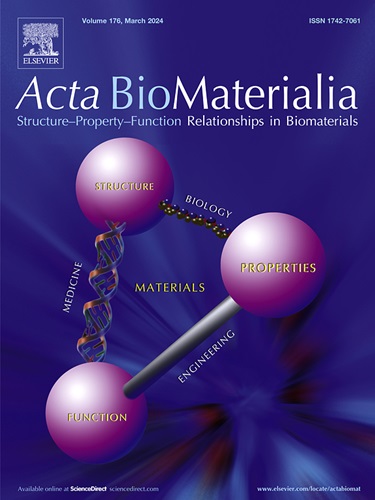基于聚合物的纳米载体通过血脑屏障运输治疗性生物大分子。
IF 9.4
1区 医学
Q1 ENGINEERING, BIOMEDICAL
引用次数: 0
摘要
治疗性生物大分子,如遗传物质、抗体、生长因子和酶,代表了神经疾病和障碍的一种新的治疗选择。传统疗法主要基于小分子药物来解决这些疾病的症状,与之相比,治疗性生物大分子可以减少不希望的副作用,并针对特定的病理途径,从而为个性化医疗铺平道路。然而,这些生物大分子在生理环境中经历降解/变性过程,并且表现出较差的穿过血脑屏障(BBB)的能力。因此,它们很少以活性形式到达中枢神经系统(CNS)。在此,我们批判性地概述了几种聚合物纳米载体,可以保护和传递治疗性生物大分子穿过血脑屏障。高分子纳米载体首先根据它们的结构(可生物降解的固体纳米颗粒、纳米凝胶、树形大分子、自组装纳米颗粒)进行分类,这最终决定了它们的物理化学性质和功能。然后对可用的聚合物配方进行彻底分析,特别关注那些确保生物大分子在包封过程中的稳定性并通过控制其物理(例如,机械性能,尺寸,表面电荷)和化学(例如,表面官能团,靶向基序)特性来促进其通过血脑屏障的策略。因此,本综述提供了一个独特的视角,为治疗性生物大分子在血脑屏障上的递送提供了一个简洁、完整和易于遵循的指南,这将是化学家、材料科学家、药理学家和生物学家的高度兴趣。此外,它也为这些系统的有限临床翻译提供了一个批判性的视角。意义声明:中枢神经系统疾病发病率的增加是一个主要的健康问题。治疗性生物大分子的使用已成为许多研究的焦点。然而,在中枢神经系统中达到治疗浓度水平的生物大分子受到血脑屏障的限制,因此,这是开发有效疗法时的主要临床挑战。在此,我们提供了一个关于使用聚合物纳米载体将治疗性生物大分子输送到中枢神经系统的关键讨论,强调了克服当前挑战的潜在未来方向。本文章由计算机程序翻译,如有差异,请以英文原文为准。

Polymer-based nanocarriers to transport therapeutic biomacromolecules across the blood-brain barrier
Therapeutic biomacromolecules such as genetic material, antibodies, growth factors and enzymes represent a novel therapeutic alternative for neurological diseases and disorders. In comparison to traditional therapeutics, which are mainly based on small molecular weight drugs that address the symptoms of these disorders, therapeutic biomacromolecules can reduce undesired side effects and target specific pathological pathways, thus paving the way towards personalized medicine. However, these biomacromolecules undergo degradation/denaturation processes in the physiological environment and show poor capacity to cross the blood-brain barrier (BBB). Consequently, they rarely reach the central nervous system (CNS) in their active form. Herein, we critically overview several polymeric nanocarriers that can protect and deliver therapeutic biomacromolecules across the BBB. Polymeric nanocarriers are first categorized based on their architecture (biodegradable solid nanoparticles, nanogels, dendrimers, self-assembled nanoparticles) that ultimately determines their physico-chemical properties and function. The available polymeric formulations are then thoroughly analyzed, placing particular attention on those strategies that ensure the stability of the biomacromolecules during their encapsulation process and promote their passage across the BBB by controlling their physical (e.g., mechanical properties, size, surface charge) and chemical (e.g., surface functional groups, targeting motifs) properties. Accordingly, this review gives a unique perspective on polymeric nanocarriers for the delivery of therapeutic biomacromolecules across the BBB, representing a concise, complete and easy-to-follow guide, which will be of high interest for chemists, material scientists, pharmacologists, and biologists. Besides, it also provides a critical perspective about the limited clinical translation of these systems.
Statement of significance
The increasing incidence of central nervous system disorders is a major health concern. The use of therapeutic biomacromolecules has been placed in the spotlight of many investigations. However, reaching therapeutic concentration levels of biomacromolecules in the central nervous system is restricted by the blood-brain barrier and, thus, this represents the main clinical challenge when developing efficient therapies. Herein, we provide a critical discussion about the use of polymeric nanocarriers to deliver therapeutic biomacromolecules into the central nervous system, highlighting potential future directions to overcome the current challenges.
求助全文
通过发布文献求助,成功后即可免费获取论文全文。
去求助
来源期刊

Acta Biomaterialia
工程技术-材料科学:生物材料
CiteScore
16.80
自引率
3.10%
发文量
776
审稿时长
30 days
期刊介绍:
Acta Biomaterialia is a monthly peer-reviewed scientific journal published by Elsevier. The journal was established in January 2005. The editor-in-chief is W.R. Wagner (University of Pittsburgh). The journal covers research in biomaterials science, including the interrelationship of biomaterial structure and function from macroscale to nanoscale. Topical coverage includes biomedical and biocompatible materials.
 求助内容:
求助内容: 应助结果提醒方式:
应助结果提醒方式:


